
The Aldine Press was the printing office started by Aldus Manutius in 1494 in Venice, from which were issued the celebrated Aldine editions of the classics. The first book that was dated and printed under his name appeared in 1495.

Giosuè Alessandro Giuseppe Carducci was an Italian poet, writer, literary critic and teacher. He was noticeably influential, and was regarded as the official national poet of modern Italy. In 1906, he became the first Italian to receive the Nobel Prize in Literature. The Swedish Academy's motivation was that "not only in consideration of his deep learning and critical research, but above all as a tribute to the creative energy, freshness of style, and lyrical force which characterize his poetic masterpieces."

Francis Petrarch, born Francesco di Petracco, was a scholar and poet of the early Italian Renaissance and one of the earliest humanists.
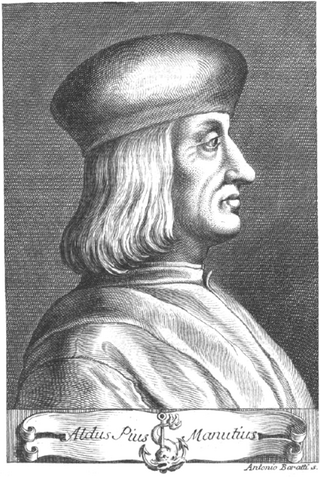
Aldus Pius Manutius was an Italian printer and humanist who founded the Aldine Press. Manutius devoted the later part of his life to publishing and disseminating rare texts. His interest in and preservation of Greek manuscripts mark him as an innovative publisher of his age dedicated to the editions he produced. Aldus Manutius introduced the small portable book format with his enchiridia, which revolutionized personal reading and are the predecessor of the modern paperback book. He also helped to standardize use of punctuation including the comma and the semicolon.
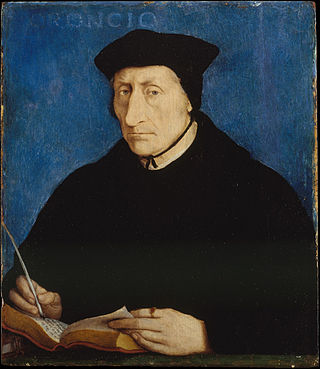
Guillaume Budé was a French scholar and humanist. He was involved in the founding of Collegium Trilingue, which later became the Collège de France.
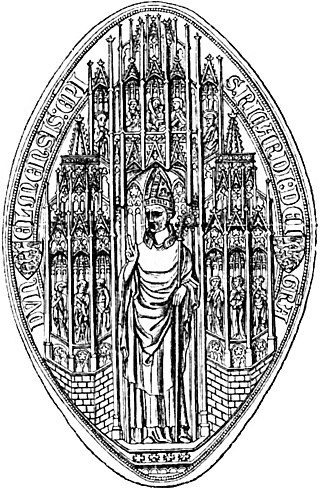
Richard de Bury, also known as Richard Aungerville or Aungervyle, was an English priest, teacher, bishop, writer, and bibliophile. He was a patron of learning and one of the first English collectors of books. He is chiefly remembered for his Philobiblon, written to inculcate in the clergy the pursuit of learning and the love of books. The Philobiblon is considered one of the earliest books to discuss librarianship in-depth.
Richard of Cirencester was a cleric and minor historian of the Benedictine abbey at Westminster. He was highly famed in the 18th and 19th century as the author of The Description of Britain before it was proved to have been a later forgery in 1846.

Gian Francesco Poggio Bracciolini, usually referred to simply as Poggio Bracciolini, was an Italian scholar and an early Renaissance humanist. He is noted for rediscovering and recovering many classical Latin manuscripts, mostly decaying and forgotten in German, Swiss, and French monastic libraries. His most celebrated finds are De rerum natura, the only surviving work by Lucretius, De architectura by Vitruvius, lost orations by Cicero such as Pro Sexto Roscio, Quintilian's Institutio Oratoria, Statius' Silvae, and Silius Italicus's Punica, as well as works by several minor authors such as Frontinus' De aquaeductu, Ammianus Marcellinus' Res Gestae, Nonius Marcellus, Probus, Flavius Caper, and Eutyches.

De viris illustribus is an unfinished collection of biographies, written in Latin, by the 14th-century Italian author Francesco Petrarca. These biographies are a set of Lives similar in idea to Plutarch's Parallel Lives. The works were unfinished. However he was famous enough for these and other works to receive two invitations to be crowned poet laureate. He received these invitations on exactly the same day, April 8, 1341, one being from the Paris University and the other from the Roman Senate. He accepted the Roman invitation.
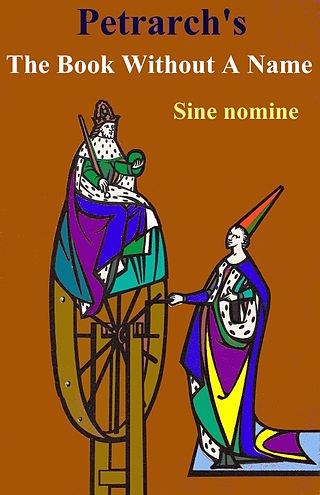
The Liber sine nomine is a collection of nineteen personal letters written in Latin by the fourteenth century Italian poet and Renaissance humanist Petrarch. The letters being harshly critical of the Avignon papacy, they were withheld from the larger collection of his Epistolae familiares and assembled in a separate book. In this fashion, Petrarch reasoned, a reader could throw away this collection, and the other letters to friends could be preserved for posterity.

Philippe de Cabassole or Philippe de Cabassoles (1305–1372), the Bishop of Cavaillon, Seigneur of Vaucluse, was the great protector of Renaissance poet Francesco Petrarch.
Dionigi di Borgo San Sepolcro OESA was an Augustinian friar who was at one time Petrarch's confessor, and who taught Boccaccio at the beginning of his education in the humanities. He was Bishop of Monopoli in Apulia. He was surnamed, not uncommonly for the trecento, for the town in which he was born, now Sansepolcro in Tuscany. His family name was de' Roberti, which no longer exists. Dionigi is the Italian form of Dennis, Latin Dionysius.
Lodewijk Heyligen was a Flemish Benedictine monk and music theorist who served as the master of music of cardinal Giovanni Colonna in Avignon. There he became one of the closest friends of the Italian poet Petrarch. His Latin name Ludovicus Sanctus means Louis the Saint and is a literal translation of the Flemish name Lodewijk Heyligen.

Omne Bonum is a 14th-century encyclopedia compiled in London by James le Palmer . It survives in four volumes in the British Library. Its author is identified on the basis of a colophon in the same hand in Bodleian Library, Laud Misc. 165. James le Palmer was a clerk of the Exchequer mentioned between 1357 and 1375.
Italica Press was founded in New York in 1985 by Eileen Gardiner and Ronald G. Musto. The press, now in its fourth decade, publishes English translations of works from the Middle Ages and Renaissance and English translations of contemporary Italian literature. It also publishes essays and collected essays in the study of art and history. It specializes in urban studies, medieval pilgrimage, medieval romances and chansons de geste, women writers, fiction, poetry, short stories and plays.

A letter collection consists of a publication, usually a book, containing a compilation of letters written by a real person. Unlike an epistolary novel, a letter collection belongs to non-fiction literature. As a publication, a letter collection is distinct from an archive, which is a repository of original documents.

The Visconti Castle of Pavia is a medieval castle in Pavia, Lombardy, Northern Italy. It was built after 1360 in a few years by Galeazzo II Visconti, Lord of Milan, and used as a sovereign residence by him and his son Gian Galeazzo, first duke of Milan. Its wide dimensions induced Petrarch, who visited Pavia in the fall of 1365, to call it "an enormous palace in the citadel, a truly remarkable and costly structure". Adjacent to the castle, the Visconti created a vast walled park that reached the Certosa di Pavia, a Carthusian monastery founded in 1396 by the Visconti as well and located about 7 kilometres (4.3 mi) to the north.

Fra Giovanni Colonna (1298? – 1343/44) was an Italian Dominican friar and scholar. Educated in France, he served as a preacher and vicar in Rome, chaplain in Cyprus and lector in Tivoli. He lived and worked in Avignon for a time and traveled widely in the Near East during his Cypriot period.
Guido Sette (1304–1367/68) was the archbishop of Genoa from 1358 until his death. He was a close friend of Petrarch.
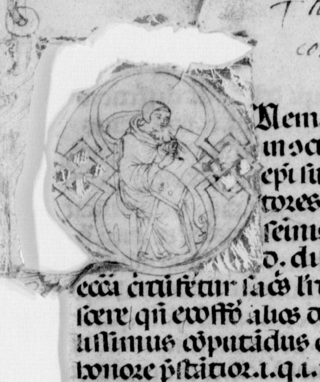
Nicolò Matafari was the archbishop of Zadar (Zara) in the Kingdom of Hungary from 1333 until his death. When his city came under the control of the Republic of Venice in 1346, he went into exile until 1358. A native of Zadar and a lawyer by training, Matafari was appointed the vicar general of the diocese of Padua in 1320, 1345 and 1355. He also served as vicar of the diocese of Castello in 1331.















